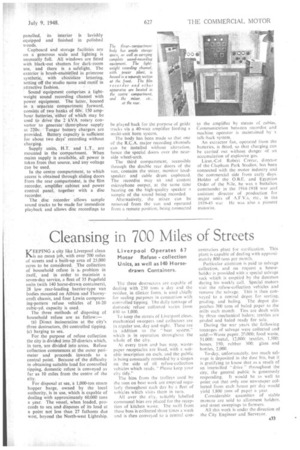Cleansing in 700 Miles of Streets
Page 51

If you've noticed an error in this article please click here to report it so we can fix it.
Liverpool Operates 67 Motor Refuse collection Units, as well as 140 Horsedrawn Containers.
KEEPING a city like Liverpool clean is no mean job, with over 700 miles of streets and a built-up area of 25,000 acres to be considered. The collection of household refuse is a problem in itself, and in order to maintain a seven-day service, a fleet of 35 Pagefield units (with 140 horse-drawn containers), 28 low .rear-loading barrier-type van bodies mounted on Albion and Thornycroft chassis, and four Lewin compressing-pattern refuse vehicles of 16-20 cubic-yd. capacity is used.
The three methods of disposing of household refuse are as follow:— (a) Direct incineration at the city's three destructors, (b) controlled tipping, (c) barging to sea.
For the purpose of refuse collection the city is divided into 20 districts which, in turn, are divided into areas. Refuse collection commences at the outer perimeter and proceeds inwards to a central point. Because of the difficulty in obtaining suitable land for controlled tipping, domestic refuse is conveyed as far as 10 miles from the centre of the city.
For disposal at sea, a 1,000-ton steam hopper barge, owned by the local authority, is in use, which is capable of dealing with approximately 60,000 tons a year. The vessel, when loaded, proceeds to sea, and disposes of its load at a point not less than 27 fathoms due west, beyond the North-west Lightship. The three destructors are capable of dealing with 230 tons a day and the residue, in clinker form, is used chiefly for sealing purposes in connection with controlled tipping. The daily tonnage of domestic refuse collected varies from 850 to 1,000.
To keep the streets of Liverpool clean. mechanical sweepers and collectors are in regular use, day and night. These are in addition to the " heat system." which is in operation throughout the whole of the city.
At every tram and bus stop, wastepaper receptacles are fixed, with a suitable inscription on each, and the public is being constantly reminded by a slogan on the side of all refuse-collection vehicles which reads. " Please keep your city tidy."
The bins from the trolleys used by the men on beat work arc emptied tvgolariy throughout each day by a fleet of vehicles which visits them in turn.
All over the city, suitably labelled communal bins are placed for the reception of kitchen waste. The swill from these bins is collected three times a week and is then conveyed to a central con
centration plant for sterilization. This plant is capable of dealing with approximately 800 tons per month.
Particular attention is paid to salvage collection, and on request a householder is provided with a special salvage sack which is emptied by the dustman during his weekly call. Special motors visit the refuse-collection vehicles and remove the salvage. This is then conveyed to a central depot for sorting, grading. and baling. The depot dispatches 300 tons of baled paper to the mills each month. Tins are dealt with by three mechanical balers; textiles are graded and baled ready for sale.
During the war years the following tonnages of salvage were collected and sold:—Waste paper, 20.000; food waste, 31.000; metal, 12,000: textiles, 1,500; bones, 350: rubber. 300: glass and bottles. 2,000.
To-day, unfortunately, too much salvage is deposited in the dust bin, but it is gratifying to know that as a result of
an intensified " ilrive throughout the city, the general public is generously
responding. It would be as well to point out that only one newspaper collected from each house per day would yield 1,800 tons of paper a year.
Considerable quantities of stable manure are sold to allotment holders, and street sweepings to farmers.
All this work is under the direction of the City Engineer and Surveyor.




















































































